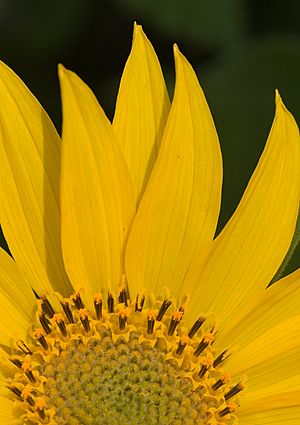Deltoid balsamroot facts for kids
Quick facts for kids Deltoid balsamroot |
|
|---|---|
 |
|
| disc florets and ray florets | |
| Scientific classification | |
| Synonyms | |
|
Balsamorhiza glabrescens Benth. |
The Deltoid Balsamroot (Balsamorhiza deltoidea) is a beautiful flowering plant. It belongs to the sunflower family. You can find it growing naturally in western North America. It lives in places from British Columbia down to California. This plant often grows in mountains and other hilly areas.
What it Looks Like
The Deltoid Balsamroot is a plant that lives for many years. It has a long, thick main root, like a carrot. The plant grows straight up. It can reach a height of about 90 centimeters (35 inches). Its stems feel a bit hairy. They also have tiny glands.
The leaves of this plant are quite large. They can be up to 25 centimeters (9.8 inches) long. They are also about 20 cm (7.9 in) wide. Their shape is like a triangle. The leaves are also hairy and have small glands. Their edges often have small teeth.
The plant usually has one or a few large flower heads. These heads are like a single big flower. Each head has special leaf-like parts called phyllaries around it. These phyllaries are hairy and pointed. They can be up to 4 centimeters (1.6 inches) long.
The center of the flower head has many small, yellowish flowers. These are called disc florets. Around the edge, there are bright yellow, pointed petals. These are called ray florets. Each ray floret can be up to 4 or 5 centimeters (1.6 or 2.0 inches) long. After the flower blooms, it makes a small fruit. This fruit is called an achene. It is about 7 to 8 millimeters (0.28 to 0.31 inches) long.
How People Used It
The Deltoid Balsamroot was very important to Native Americans. They used it for both food and medicine. The seeds of the plant were eaten. People ate them raw or cooked. Sometimes, the seeds were ground into flour. This flour was used to make breads or cakes.
The roots were also a food source. They could be eaten raw or cooked. When roasted, the roots could even be used to make a drink like coffee. Young shoots of the plant were also eaten. They were a fresh green vegetable. Besides food, the roots were used as a medicine. They helped to treat colds.

